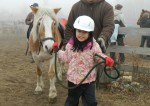Connecting through Animals
March 26, 2013
After running our therapeutic riding program for almost two years, I have become more attuned to the therapeutic quality of the interaction between people and animals. I have enjoyed observing the difference in the youngsters who attend our riding program and was gratified to see this article focusing on how such classes can benefit adults: Therapeutic Riding as a Means of Teaching Job Skills.
More recently, I read about the boost animals give to social interaction in children and how therapy dogs help individuals with autism. The connection between animals and individuals with autism is well-known, and it isn’t limited to children. Adults, too, develop deep bonds with animals—maybe because animals don’t judge. Through unconditional acceptance, I believe that individuals are more apt to connect with others and believe in themselves when an animal is present.
We at Erik’s Ranch & Retreats have seen first-hand the value of partnering animals with individuals with autism. In nearly all instances, therapeutic riding students have had remarkable experiences as the father of Jack, a 12-year-old with autism, describes: “Here is a little slice of life from Jack’s experience. Jack and Bailey [the horse] were trotting around the arena. Jack was posting, and as he stood up in his stirrups, Bailey leaped two feet in the air. She came off the jump into a cantor. A huge smile broke out across Jack’s face, as he thrust his little fists up into the air. I asked Jack how it felt. He said, ‘It felt like flying.’ As his parents, we felt like we’d just jumped over every obstacle we’ve ever had.”
I have spoken with most of our parents, who are always thrilled at the changes our classes bring about in their children. One mother told me that before she enrolled her son in therapeutic riding classes, she’d cringe each time the phone rang. She was sure another group or program couldn’t handle her son and she’d be asked to remove him from the program. But, therapeutic riding had such a positive impact on her son that, she says, she will drive to the ends of the earth to get him to his class.
Another mother has a daughter, Katie, with autism, who is allergic to horses, but the impact on Katie has been so great they work around the allergies. Katie’s mother says, “Riding really triggers her sensory system in a positive way. The motion and movement are so calming and positive. She started out on a Western saddle and gradually shifted to an English saddle as you can really feel the horse better with an English saddle. She’s learned to steer the horse, use verbal commands, play games, and best of all, trot and canter.
There are so many creative and innovative ways to help children and adults with autism integrate into a world that misunderstands and sometimes avoids them. It has long been obvious that animals provide a catalyst for people to interact, and I, for one, am thrilled to see these methods being employed as assistance to help integrate individuals with autism.
Tell us about classes or groups that help your loved one with autism. Everyone will benefit from knowing what is available.
